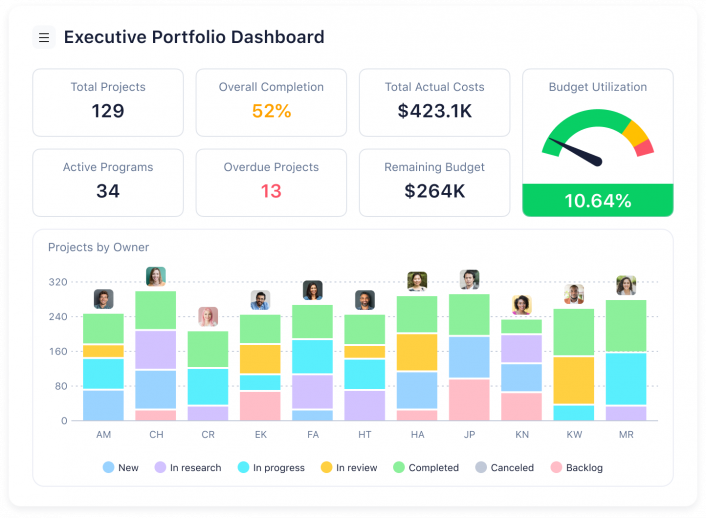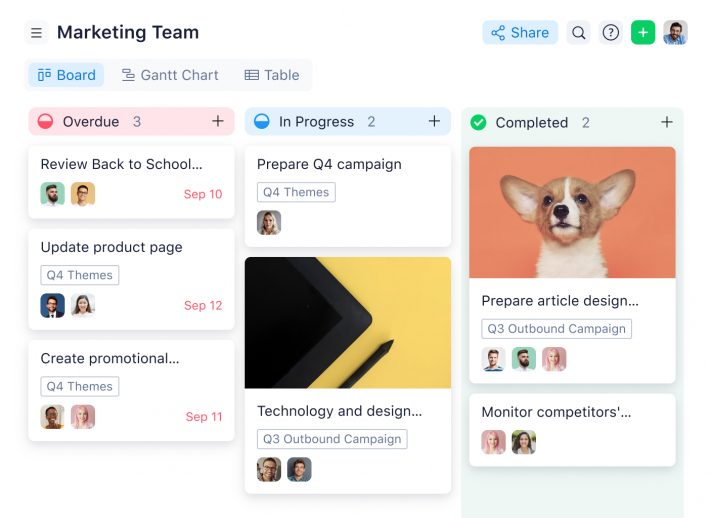Key takeaways:
- What is the primary difference between a project and a program? Projects are temporary, one-off tasks with specific deliverables, while programs consist of multiple interconnected projects aimed at achieving broader business objectives.
- What are the main roles of a program manager? Program managers define strategy, oversee multiple projects, and ensure alignment with long-term goals, fostering collaboration and measuring impact.
- How do project managers differ from program managers? Project managers focus on executing individual projects, managing timelines and budgets, while program managers maintain a strategic focus across connected projects.
- What tools help program and project managers collaborate effectively? Dashboards, templates, flexible views, and in-context collaboration features streamline operations and enhance communication.
- How do salaries compare for program managers vs. project managers? Program managers typically earn slightly more, with average salaries around $105,000, while project managers average around $98,000, varying by industry and experience.
Program manager vs. project manager — roles with titles that similar couldn’t possibly be too different, right? Wrong!
While program managers and project managers share similar responsibilities, there are key differences between the two positions. The same thing goes for program management vs. project management. So whether you’re considering either as a future career or are looking to understand how these two camps might work better together, it’s important to know how they relate to each other.
In this guide, we’ll dig into the difference between a project manager and program manager as well as how they can collaborate more effectively (hint: the right technology matters).
If you want to get a jump start, you can start a two-week trial with Wrike today.
Projects vs. programs
Before we discuss the similarities and differences between the two roles, it’s crucial to understand what separates projects from programs.
Projects are temporary, one-off undertakings. They are generally bound by cost, resources, budget, and time constraints. Projects have clear end dates and short-term goals that give way to tangible outcomes or deliverables.
Programs are composed of several underlying, interconnected projects. These projects complement and build off one another to achieve a larger, long-term business objective. A successful program drives strategic benefits and organizational growth rather than a single, tangible deliverable.
The grid below offers a helpful side-by-side comparison of projects vs. programs:

Project vs. program examples
One of the best ways to understand what makes a project different from a program is to look at a few examples.
Let’s say a company wants to convert more CIOs. It might ask its marketing team to create a demand generation program to drive CIO interest and conversion. Several projects — creating a CIO-targeted eBook and hosting a CIO-related webinar, for example — might then go into this program.
Or imagine that you’ve decided to create or overhaul your onboarding program for new employees. That program would involve numerous smaller projects, such as running a survey of recent hires about their own onboarding experience, establishing checklists and templates, and creating a standardized training presentation for new hires.
Remember, a program is a long-term initiative while a project is a one-off deliverable. So, in most cases, programs are made up of several different projects that help work toward that bigger vision.
What is a program manager?
A program manager articulates a program’s strategy and objectives and assesses how it will impact a business. They must define and oversee a list of dependent projects needed to reach the program’s overall goals.
Think of a program manager as an architect who sketches a blueprint. While architects don’t install plumbing or drywall, they make sure all these pieces come together to create a beautiful home. The program manager’s role extends beyond the completion of individual projects to the long-term realization of the whole program.
Their responsibilities include enlisting teams, implementing strategies, measuring ROI, and other big-picture initiatives. Going back to our CIO example, a program manager’s duties might include overseeing collaboration across project teams and defining whether or not an uptick in CIO lead conversion is a good success metric.
To get a better idea of a day in the life of a program manager, check out some typical program manager job descriptions here.

What is a project manager?
Project managers oversee the operations of individual projects within programs. They coordinate time, budget, and resources to complete work within program guidelines and report to the program manager on progress and any changes made to the initial project plan.
The role of the project manager is more tactical than the program manager. If program managers are architects, project managers are painters, plumbers, and electrical engineers.
They focus mainly on execution and managing the functional elements of the project. This includes meeting deadlines, staying within budget, delegating tasks, and completing deliverables.
Program managers vs. project managers
Let’s recap the three main differences between program managers vs. project managers:
- Program managers supervise groups of projects; project managers oversee individual projects
- Program managers focus on long-term business objectives; project managers have short-term, concrete deliverables
- Program managers are strategic; project managers are tactical
Need some more information on project management and project management methodologies? Check out this helpful video.
How do program and project managers work together?
Many organizations have both program and project managers. And while a basic understanding of program vs. project management can clue you in on the typical responsibilities of each role, there can still be some confusion here — particularly since there is quite a bit of overlap between the two positions.
The most important thing to keep in mind is that the program manager drives the overall strategic vision while the project manager coordinates and oversees the tactical work that feeds that broader vision.
Those are different roles but with plenty of commonalities. For example, both will need to set metrics and monitor progress, but the ways they do so could differ. The program manager might keep an eye on the impact of different implementation stages of the program, while the project manager would track completed tasks, deliverables, and deadlines.
In many cases, the project vs. program manager dynamic is hierarchical, as the project manager often reports directly to the program manager. But in other situations or organizations, the two roles work more collaboratively or as a partnership to move projects — and the overall initiative — in the right direction.
Regardless of if there’s a defined supervisory relationship or not, project and program managers need to have the following to work together seamlessly:
- Frequent, clear, and effective communication with each other and their teams
- Clear roles so that they and their teams understand their unique responsibilities
- Established processes to move both projects and programs forward
- Defined expectations so everybody knows who should focus on what
- Technology that provides full visibility into both projects and programs
Much like any other workplace dynamic or relationship, there isn’t a default blueprint project and program managers need to follow to work together effectively.
The interaction between a project and program manager at your organization might look completely different from another organization — ultimately, the important thing is that it works well for you.
What is the salary of a program manager and a project manager?
So, you might be wondering: How much do project managers make? What about program managers? Are their salaries comparable?
Typically, a project manager salary can range anywhere from $59,000 to $134,000 per year, with the average being about $98,000 per year. However, project management is a broad field and those numbers can vary greatly depending on specific roles, industries, and specialties.
For example, how much does a construction project manager make? The average is closer to $75,000 per year. Or how much does an IT project manager make? The average salary is higher, at about $89,000 per year. What about other engineering project management roles? That tops the list, with an average salary of over $119,000 per year.
In short, there are multiple kinds of project manager positions that exist — however, the salary usually varies depending on the role of the project manager, location, and experience.
Interested in learning how to become an IT project manager or how to become a construction project manager? Consider learning more about how to become a project manager if it piques your interest.
So what about a program manager? How much can you expect to earn in this role? Again, compensation differs depending on industry, location, experience, and other factors. However, in general, program managers command a slightly higher salary than project managers — with a national average salary of a little over $105,000 per year.
Different roles, similar challenges
Despite having different day-to-day responsibilities, both program managers and project managers oversee many moving parts and must exhibit extreme organization and efficiency. They encounter many of the same challenges and benefit from using similar techniques and tools:
- Dashboards: A clear view of task statuses and progression is crucial when success depends on multiple people and moving parts. Every program and project manager should have a dashboard to show them exactly who is working on what at a single glance. Ideally, this dashboard will provide both a bird’s-eye view and the ability to drill down when necessary.

- Templates: Many programs have similar projects. For example, every marketing project might contain an ad campaign. Rather than reinvent the wheel, project and program managers should templatize their work. This minimizes the need to start new initiatives from scratch and helps duplicate past success.
- Flexible work views: Not everyone works the same way. Program and project managers’ jobs are much easier when they don’t force their work styles on others. It’s important for them to be able to view a single program or project from different angles — think Kanban boards, tables, lists, and timelines. This means everyone involved can stay aligned while working in a way they find comfortable.

- In-context collaboration: Keeping track of every asset, update, and request can be difficult. Digging through emails and spreadsheets for details is a waste of project and program managers’ time. Keeping all program and project communications in a single, easily referenceable thread is extremely helpful.
Wrike’s management software makes programs and projects easier
Program managers and project managers have one big thing in common: they’re both important. You need both the strategic vision and the tactical expertise to build impactful programs and deliver winning projects.
But simply having a program and project manager on your payroll doesn’t guarantee success — you also need to equip them with the right support, resources, and tools.
With dashboards, templates, flexible work views, and in-context collaboration, Wrike offers all of the must-have features. Plus, you’ll find plenty of others that will help your program managers, projects managers, and their entire teams work seamlessly together. Within one, centralized platform, you can plan projects, organize tasks, communicate with team members and stakeholders, track progress, and report analytics.
Say goodbye to clicking between spreadsheets or losing important updates in siloed instant messages or endless email threads. Wrike brings your entire team together — and helps you get more top-notch projects and programs across the finish line.









